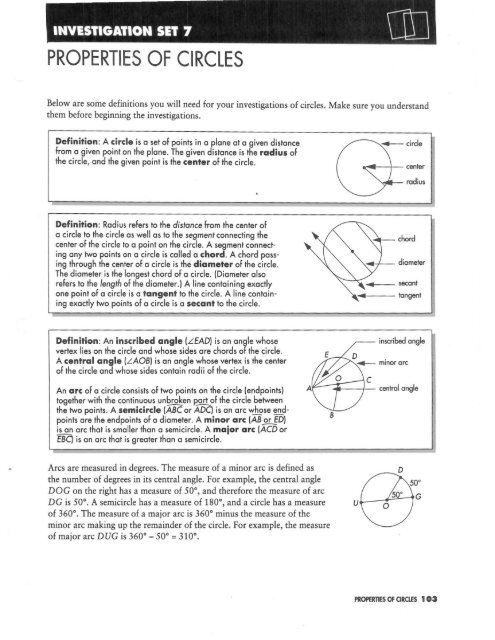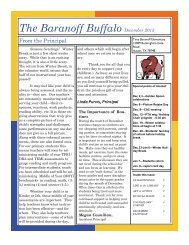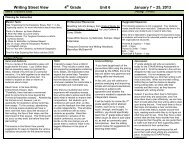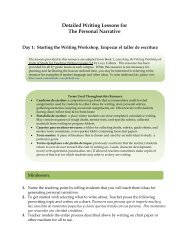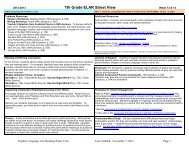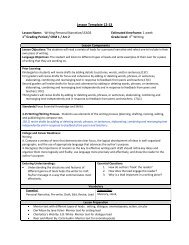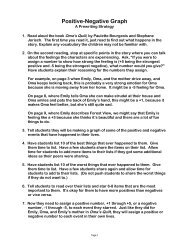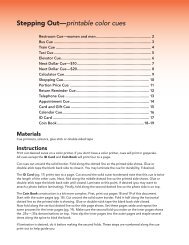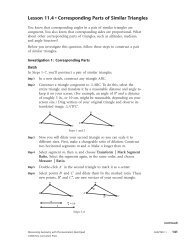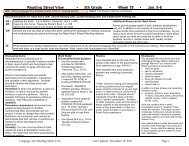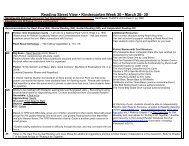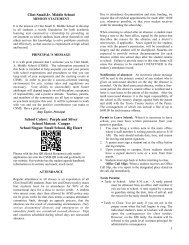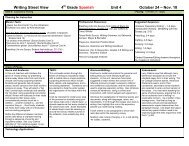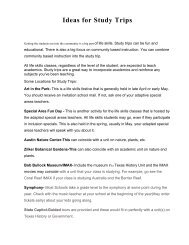PROPERTIES OF CIRCLES
PROPERTIES OF CIRCLES
PROPERTIES OF CIRCLES
Create successful ePaper yourself
Turn your PDF publications into a flip-book with our unique Google optimized e-Paper software.
INVESTIGATION SET 7<strong>PROPERTIES</strong> <strong>OF</strong> <strong>CIRCLES</strong>CUJBelow are some definitions you will need for your investigations of circles. Make sure you understandthem before beginning the investigations.Definition: A circle is a set of points in a plane at a given distancefrom a given point on the plane. The given distance is the radius ofthe circle, and the given point is the center of the circle.:4--- circle.....11---4- center~"'
Chords and inscribed angles form a special type of quadrilateral.Definition: A cyclic quadrilateral is a quadrilateral thaI can beinscribed in a circle.'04 INVESTlGATION SET 7
Guided Inyestlgatlon 7. I continuedFINDING THE CENTER <strong>OF</strong> A CIRClEStep 5: On another patty paper use your compassto draw an arc of a circle.Step 6: Fold or draw two chords on your arc.Step 7:Fold the perpendicular bisector of each chord,and mark the point of intersection of the folds.,,,Step 8: Use your compass to verify that this pointof intersection is the center of the circle thatcontains the arc you drew in step 5.Use your results to complete the following conjecture:17.:! The perpendicular bisectors of two chords of a circle (or an arc of a circle) intersect~44 atthe .This technique gives you an easy way to find the center of a circle when you only have an arc.'06 INVESllGA110N SET 7
Step 1:Guided Inve.tlgatlon 7.2TANGENTS TO A CIRCLETake one of your parry papers with a circledrawn on it and draw or fold a line thatappears to be a tangent to your circle. (Ifnecessary, make two small, pinched creasesto mark the center of your circle.),oStep 2: Fold a line that passes through the centerof your circle and the point of tangency.Step 3: Place the corner of another parry paper at theangle formed between the radius (or diameter)and the tangent. What do you observe?Step 4: Draw another tangent to the same circle and repeat steps 1 and 2.Compare your results with the results of others near you. Your next parry paper conjecture could be:~ A tangent to a circle is _____ _ _ __ to the radius (or diameter) drawn to the~ 45 point of tangency.In this investigation you eyeballed a tangent to the circle. You can use this conjecture to fold a tangentto a circle at a given point.Step 5: Take another patry paper with a circle on it.Fold a diameter and mark a point where thediameter intersects the circle.Step 6: Fold a line perpendicular to the diameter throughthe point where the diameter intersects the circle.This line should be tangent to the circle.,(]",, ' ,, , , ,,,<strong>PROPERTIES</strong> <strong>OF</strong> CIRClfS I 07
Step 1:Guided Invesligalion 7.5INSCRIBED ANGLESTake one of your patty papers with a circleon it and fold or draw an inscribed angle.Step 2:Fold or draw a central angle intercepting thesame arc as the inscribed angle.Step 3: With another patty paper, make a copy ofthe inscribed angle.Step 4:Slide the copy of the inscribed angle on thesecond patty paper over the central angle onthe original patty paper. How many times willthe inscribed angle fit in the central angle?(:-tr\'" /Compare your results with the results of others near you. You should be ready for your next pattypaper conjecture. Your next patty paper conjecture could be:~ The measure of an inscribed angle is ______ the measure of the central angle~ 48 intercepting the same arc.110 INVESTIGATION SET 7
c::J_G_u_ld_e_d __ ln_y_e_SI_I~g_al_l_o_n_7_._6 ____________________________~ ANGLES INSCRIBED IN THE SAME ARCStep 1:Take one of your patty papers with a circleon it and fold or draw an inscribed angle.Step 2:Fold or draw a different inscribed angleintercepting the same arc as the first.Step 3: With another patty paper, make a copy ofone of the inscribed angles.Step 4:Rotate and slide the copied inscribed angleover the other original inscribed angle. Howdo their sizes compare?Step 5:Fold or draw a third inscribed angle interceptingthe same arc as the other two angles. Comparethe size of this third inscribed angle with the sizeof the other two angles.Compare your results with the results of others near you. Your next patty paper conjecture could be:~ 49 Inscribed angles that intercept the same arc are ___ _ __________ _<strong>PROPERTIES</strong> <strong>OF</strong> <strong>CIRCLES</strong> I I I
c:::J ~G~u~id=.~d~l=n~y~.=sl~ig~a='i~o~n~7~.7~ ____________________________ _~ ANGLES INSCRIBED IN A SEMI<strong>CIRCLES</strong>tep 1:Take one of your patry papers with a circleon it and fold a diameter.Step 2:Fold an angle inscribed in one of the semicircles.Step· 3:Use the corner of another patry paper tomeasure the inscribed angle. What doesthe measure of the angle appear to be?Step 4:Repeat steps 2 and 3 with another angle inscribed in the semicircle.Compare your results with the results of others near you. Your next patty paper conjecture could be:~ 50 The measure of an angle i~scribed in a semicircle is _ _ ___ _ _ _ _ _ _ _II 2 INVEST1GAT1ON SET 7
c::J Guided Invesligalion 7.8~ PARALLEL LINES THROUGH A <strong>CIRCLES</strong>tep 1:Take one of your patry papers with a circledrawn on it. Use your straightedge to draw apair of parallel lines passing through the circle.Step 2:Compare the sizes of the arcs between theparallel lines by folding one arc onto the other.How do the lengths of the arcs compare? Are thetwo arcs outside the parallel lines the same size?, ,Step 3:Repeat steps 1 and 2 with another pair of parallel lines. (If possible, use a different-widthruler to draw your lines.)Compare your results with the results of others near you. Your next patry paper conjecture could be:~ 51 Parallel lines intercept _________________ arcs on a circle.PROPERnES <strong>OF</strong> <strong>CIRCLES</strong> I I 3
Step 1:Guided Investigation 7.9CYCLIC QUADRILATERALSStart with a circle on a patty paper andfold a cyclic quadrilateral., ,,,Step 2: Trace your cyclic quadrilateral on anotherpatty paper.Step 3: Rotate and slide the copy over the originaland look for any relationships between pairsof angles.AV,"Step 4: Copy a pair of opposite angles so that theyshare a vertex and a side. Do this with theother pair of opposite angles. What do younotice about the sum of the measures of theangles in each case?Step 5: Repeat steps 1-4 with another cyclic quadrilateral., ,, ,~, ' , ,, ,,,, , , ,,,';f .Compare your results with the results of others near you. Your next patty paper conjecture could be:\ 0,,'-r:bla~ 52 The sum of the measures of a pair of opposite angles in a cyclic quadrilateral is _ _ _1 14 INVEST1GATlON SET 7
c::J Open Investigation 7.'~ FINDING THE CENTER <strong>OF</strong> A CIRCLEBefore you begin the circle investigations you should take a supply of patty papers and construct alarge circle on each one. (A dozen will do.) Use a compass with a felt-tip pen or use a cup or glass as atemplate to make the circles.Step 1:Draw a circle on a patty paper. (If possible,do not use a compass.) See if you can discovera way to find the center of the circle by folding.Describe your method for finding the center of the circle.oStep 2:Step 3:Step 4:Step 5:Step 6:Step 7:Step 8:Take out another patty paper with a circle on it. Fold or draw two chords on your circle.Fold the perpendicular bisector of each chord.Use your compass to verify that the point of intersection of the perpendicular bisectors is thecenter of the circle.On another patty paper use your compass to draw an arc of a circle.Fold or draw two chords on your arc.Fold the perpendicular bisector of each chord, and mark the point of intersection of the twoperpendicular bisectors.Use your compass to verify that this point is the center of the circle that contains the arc youdrew in step 5.Use your results to write a conjecture about the point of intersection of the perpendicular bisectors oftwo different chords of a circle (or an arc of a circle).~44<strong>PROPERTIES</strong> Of CIRruS "5
~Step 1:Open Investigation 7.2~..!!!!
Open Investigation 7.4CENTRAL ANGLES, ARCS, AND CHORDSStep 1:Take one of your patty papers with a circleon it and fold a central angle. (You may needto find the center of the circle first.)Step 2:Step 3:Use another patty paper to trace the central angle. Then retrace the angle in the originalcircle so that you have two central angles (that are not vertical angles) with the samemeasure. (It will be easier to do the investigation if the two angles do not overlap.)Fold or trace to compare the lengths of the intercepted arcs and the chords of the twocentral angles.Step 4: Repeat steps 1-3 with another pair of congruent central angles.Compare your results with the results of others near you. Write a conjecture about the lengths of theintercepted arcs and chords of two congruent central angles.~47Open Investigation 7.5INSCRIBED ANGLESStep 1:Take one of your patty papers with a circleon it and fold or draw an inscribed angle.Step 2:Step 3:Fold or draw a central angle intercepting the same arc as the inscribed angle.Compare the measures of the central angle and the inscribed angle.Compare your results with the results of others near you. Write a conjecture about the relationshipbetween the measures of an inscribed angle and the central angle intercepting the same arc.~48<strong>PROPERTIES</strong> <strong>OF</strong> CIRClfS 11 7
c::::J Open Investigation 7.6~ ANGLES INSCRIBED IN THE SAME ARCStep 1:Take one of your patty papers with a circleon it and fold or draw an inscribed angle.Step 2:Step 3:Step 4:Fold or draw a different inscribed angle intercepting the same arc as the first.Compare the measures of the two inscribed angles.Fold or draw a third inscribed angle intercepting the same arc as the other two angles.Repeat step 3 with this third inscribed angle.Compare your results with the results of others near you. Write a conjecture that compares the sizes ofinscribed angles that intercept the same arc.~49c::::J _O~p_e_n_l_n_v_e_st_i~ga_t_i_o_n_7_._7 ______________________________ _~ ANGLES INSCRIBED IN A SEMI<strong>CIRCLES</strong>tep 1:Take one of your patty papers with a circleon it and fold a diameter.Step 2:Fold an angle inscribed .in one of the semicircles.Step 3: Use the corner of another patty paper to measure the inscribed angle. What does themeasure of the angle appear to be?Step 4:Repeat steps 2 and 3 with another angle inscribed in the semicircle.Compare your results with the results of others near you. Write a conjecture about the measure of anangle inscribed in a semicircle.~50, ,. INVESTlGA110N SET 7
c:::J_O~p~e_n_l_n_y~e~s'~iLg~a'~i~o~n~7~.~8~ ____________________________ _~ PARALLEL LINES THROUGH A <strong>CIRCLES</strong>tep 1:Take one of your patty papers with a circledrawn on it. Use your straightedge to draw apair of parallel lines passing through the circle.Step 2:Compare the sizes of the arcs between the parallel lines. How do the lengths of thearcs compare?Step 3: Repeat steps 1 and 2 with another pair of parallel lines. (If possible, use a ruler with adifferent width to draw your lines.)Compare your results with the results of others near you. Write a conjecture about the lengths of thearcs formed between a pair of parallel lines.~5'c:::J_O~p_e_n_l_n_y_e_s'~ig~a_'_io_n __ 7_._9 _______________________________~ CYCLIC QUADRILATERALSStep 1:Start with a circle on a party paper, and folda cyclic quadrilateral.- ,, ,Step 2: Trace your cyclic quadrilateral onto another patty paper., ,, ,Step 3: Rotate and slide the copy over the original and look for any relationships between pairsof angles.Step 4: Copy a pair of opposite angles so that they share a vertex and a side. Do this with the otherpair of opposite angles. What do you notice about the sum of the measures of the angles ineach case?Step 5: Repeat steps 1-4 with another cyclic quadrilateral.Compare your results with the results of others near you. Write a conjecture about the relationshipbetween a pair of opposite angles in a cyclic quadrilateral.~52PROPERnES <strong>OF</strong> CIRCUS 11 9
EXERCISE SET 7 ASketch and carefully label each figure.1. A circle with diameter AB2. A circle with central angle LTOP3. A circle with inscribed angle LZAP......4. A circle with secant SP and central angle LSOP...... ......5. A circle with tangent AT and secant A 06. A circle with inscribed quadrilateral FO UR7. A circle with inscribed quadrilateral QUAD, where LADQ is a right angle8. A circle with diameter AB and with MBC inscribed in a semicircle'20 INVESTIGATION SET 7
EXERCISE SET 78Using the rules of patty paper geometry, try to construct each figure. When only one figure can beconstructed using the given information, we say the given information determines a unique figure. Ifthis is the case, write unique next to the figure. If more than one figure can be constructed using thegiven information, write more than one solution next to the figure. If it is impossible to construct afigure using the given information, write none.1. Given the three segments below as sides, construct a triangle .•• •2. Given the two segments below as sides, construct a kite .• •3. Given the segment below as a side, construct a rectangle .• •4. Given the segment below as a diagonal, construct a rhombus.• •5. Given the segment below as a diagonal, construct a square.• •6. Given the two segments below as diagonals, construct a parallelogram .• • •7. Given the two segments below as sides and the angle as one of the angles, construct aparallelogram.••• •• •8. Given the two segments below as sides and the angle as one of the angles, construct a kite .• •• •<strong>PROPERTIES</strong> <strong>OF</strong> <strong>CIRCLES</strong> 1 21
EXERCISE SET 7CUse your patty paper conjectures to calculate the length of each lettered segment and the measure ofeach lettered angle.1. 2. 3. d 103'22'efe 88'4. 5.eab6.105'd44'75' 66' e7. 8. 9. 78 emaeb40 em10. 11. 12.•24m13. 152':14. 15 .b•'22 INVES11GATION SET 7
EXERCISE SET 7DUse your patty paper conjectures to calculate the length of each lettered segment and the measure ofeach lettered angle and arc.1.n k p\ ,9c- -2. AG and AC are tangents.K• QG9A<strong>PROPERTIES</strong> <strong>OF</strong> CIRruS 1 23
~ ~3. AB and A C are tangents.m8 FkaA~~d~ ______ ~D~ ______________ -+~~~O ____________ ~EhxbcEXERCISE SET 7EUse the rules of patty paper geometry to construct each figure. When only one figure can beconstructed using the given information, we say the given information determines a unique figure. Ifthis is the case, write unique next to the figure. If more than one figure can be constructed using thegiven information, write more than one solution next to the figure. If it is impossible to construct afigure using the given information, write none." A~_o ---'08 ~~,.. __1. Given AB and CD as sides, construct a kite.2. Given AB as a side, construct a rectangle.c_._o=============- .. ,;:------__ o D .. ~ H3. Given CD as a diagonal, construct a rhombus.4. Given CD as a diagonal, construct a square.S. Given AB and CD as diagonals, construct a parallelogram.6. Given AB and CD as sides and LH as one of the angles, construct a parallelogram.7. Given AB and CD as sides and LG as one of the angles, construct a kite.8. Given CD as a diagonal and LH as one of the angles, construct a rhombus.'24 INVESTIGATION SET 7
c:::J_ln_v_e_s_tl~g~a_tl~o~n~Se~t~6~ ________________________________ _~ <strong>PROPERTIES</strong> <strong>OF</strong> QUADRIlATERALSPPC-33PPC-34PPC-35PPC-36PPC-37PPC-38PPC-39PPC-40PPC-41PPC-42PPC-43The opposite sides of a parallelogram are congruent.The opposite angles of a parallelogram are congruent.The point of intersection of the diagonals of a parallelogram is the midpoint of eachdiagonal.If two parallel lines intersect a second pair of parallel lines that are the same distanceapart as the first pair, then the parallelogram formed is a rhombus.The diagonals of a rhombus bisect the angles.The diagonals of a rhombus are perpendicular to each other.The diagonals of a rectangle are congruent.The angles formed by the intersection of the diagonals of a kite are right angles.Exactly one pair of opposite angles of a kite are congruent.Exactly one diagonal of a kite is the perpendicular bisector of the other.Exactly one pair of opposite angles of a kite are bisected by a diagonal.~Investigation Set 7---""-------<strong>PROPERTIES</strong> <strong>OF</strong> <strong>CIRCLES</strong>PPC-44PPC-45PPC-46PPC-47PPC-48PPC-49PPC-50PPC-51PPC-52The perpendicular bisectors of two chords of a circle (or an arc of a circle) intersect at thecenter of the circle.A tangent to a circle is perpendicular to the radius (or diameter) drawn to the point oftangency.Tangent segments to a circle from a point outside the circle are congruent.The intercepted arcs and chords of two congruent central angles are congruent.The measure of an inscribed angle is one-half the measure of the central angleintercepting the same arc.Inscribed angles which intercept the same arc are congruent.The measure of an angle inscribed in a semicircle is 90°.Parallel lines intercept congruent arcs on a circle.The sum of the measures of a pair of opposite angles in a cyclic quadrilateral is 180°.CONJECTURE UST 237
EXERCISE SET 6E1. more than one possible solution2. more than one possible solution3. more than one possible solution4. one possible solution5. one possible solution6. one possible solution7. one possible solution8. one possible solution9. more than one possible solution10. more than one possible solution11. one possible solution12. more than one possible solution13. more than one possible solutionEXERCISE SET 6FAnswers will vary. See student work.EXERCISE SET 6G1. a = 63°, b = 63°, c = 117°, d= 63°,e= 63°,(= 54°,g= 126°, h = 54°, k = 90°,m = 540,n = 54°,P = 126°, r = 36°, s = 810, t = 25°, u = 126°, v = 115°2. a = 86°, b = 86°, c = 60°, d = 108°, e = 108°, g = 76°, h = 520, k = 64°, m = 128°, n = 52°,P = 13]0, r = 140°, s = 140°, t = 40°, v = 150°EXERCISE SET 7 AAnswers will vary. See student work.EXERCISE SET 7B1. one possible solution2. more than one possible solutionANSWER KEY 253
3. more than one possible solution4. more than one possible solution5. one possible solution6. more than one possible solution7. one possible solution8. more than one possible solutionEXERCISE SET 7C1. d = 2r, e= 68°,(= 90°2. a = 76°, b = 76°, c = 28°3. d = 57°4. e = 136°, ( = 66°5. a = 75°, b = 105°, c = 114°6. d = 75°, e = 105°7. (= 110°8. a = 108°, b = 37 m9. c = 59 em10.d=15eml1.a=13m12. a = 24 m13. b = 152°14. c = 70°15. a = 90°, b = 90°, c = 118°EXERCISE SET 7D1. a = 54°, b = 63°, c = 63°, d = 36°, e = 27°, ( = 54°, g = 63°, h = 36°, k = 126°, m = 72°, n = 720,P = 54°2. b = 900, c = 46°, d = 78°, e = 44°, ( = 136°, g = 54°3. a =56°, b = 56°, c = 124°, d = 34°, e = 28°, (= 90°, g = 62°, h = 34°, k = 56°, m = 68°254 PAm PAPER GEOMETRY
EXERCISE SET 7E1. more than one possible solution2. more than one possible solution3. more than one possible solution4. one possible solution5. more than one possible solution6. one possible solution7. more than one possible solution8. more than one possible solutionEXERCISE SET 8AAnswers will vary. See student work.EXERCISE SET 8B1. !!.BIG = !!.FA] by SAS2. ·cannot be determined3. !!.OPN = LillWE by ASA4. !!.FLP =!!. VRO by SSS5. !!.HOT = Lill YA by SAS6. !!.CLD = !!.GNH by AAS7. !!.CAT = !!.MSE by ASA or AAS8. !!.HIP = !!. TA C by SAS9. cannot be determined10. cannot be determined11. !!.Q UD = MD U by SSS, ASA, AAS, or SAS12. !!.PAT = !!.TYP by SASEXERCISE SET 8CEach exercise has one possible solution, except problem 3, which has two possible solutions.ANSWER KEY 255


